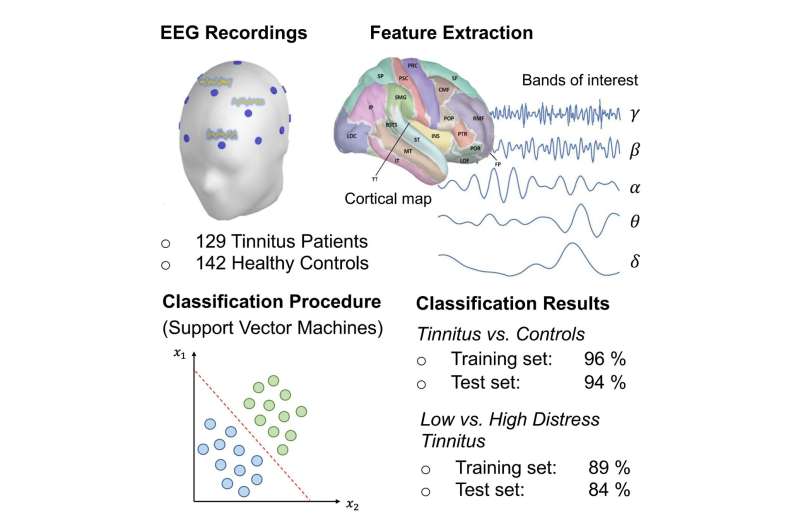New EEG procedure accurately measures distress caused by tinnitus

While it’s especially common in older adults, tinnitus—a potentially devastating ringing in the ears—can affect people of all ages. Most often described as consistent buzzing, hissing or humming, tinnitus is usually caused by an underlying condition, like age-related hearing loss, an ear injury or heart disease and affects approximately one in five people in North America.
Because the noise an affected individual hears isn’t caused by an external sound and there are no discernible biomarkers, it’s extremely difficult for clinicians to assess, diagnose and treat tinnitus.
A new study led by Andrea Soddu may provide a clearer picture of the levels of distress tinnitus sufferers are experiencing. The Western medical physicist and an international team of collaborators have developed a new classification procedure for tinnitus patients using data acquired by electroencephalography (EEG), a technique that measures electrical activity in the brain using small electrodes placed on the scalp.
EEG is easier to use, less expensive and far more accessible than functional magnetic resonance imaging (fMRI), often considered the medical industry standard. The findings and new EEG testing procedure were published today in the journal Brain Communications.
“Tinnitus is usually the result of external damage to the ear and some sound frequencies can no longer be properly transmitted,” said Soddu, physics professor and Western Institute for Neuroscience faculty member. “The brain tries to make sense of the lack of information and builds up its own interpretation and that’s why you get this constant whistling in your ear. Your brain is trying to help, but it actually makes things worse.”
The new procedure, designed by University of Pisa (Italy) postdoctoral researcher Andrea Piarulli, required two classifiers based on brain electrophysical activity that can accurately distinguish tinnitus patients from healthy controls, as well as tinnitus patients with low and high distress levels.
“The classifiers, employed in recognizing the brain pathology of tinnitus, relied on very different electrophysiological parameters from the ones used to classify distress levels. We are convinced this new procedure will be applicable for other neurological conditions like post-traumatic stress disorder (PTSD), chronic pain, and disorders of consciousness as it can accurately pinpoint distress biomarkers,” said Western graduate student and study co-author Idan Nemirovsky.
For the study, EEG recordings were acquired from 129 tinnitus patients and 142 healthy controls. The classifier for healthy controls and tinnitus patients performed with an average accuracy of 96 percent and 94 percent for the training and test sets, respectively. For the distress classifier, these average accuracies were 89 percent and 84 percent.
More information:
Andrea Piarulli et al, Tinnitus and distress: an electroencephalography classification study, Brain Communications (2023). DOI: 10.1093/braincomms/fcad018
Journal information:
Brain Communications
Source: Read Full Article


